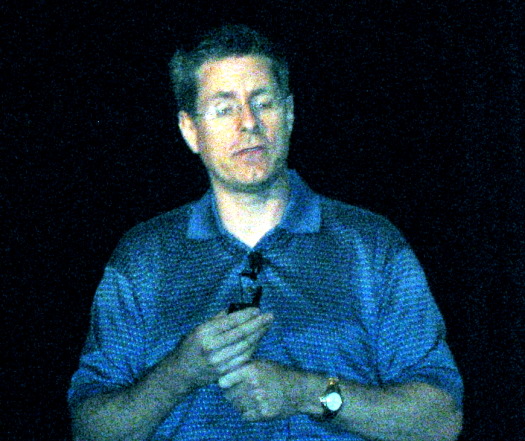This year’s attendance at Denali’s MemCon seems at least as big as last year’s. I don’t have actual numbers but the presentation hall was nearly full – and it is a big hall.
Phase Change Memory
I found the first two presentations to be the most interesting. The first was by Ed Doller, the CTO at Numonyx.

Sorry about the photo, Ed.
Ed talked about Numonyx’s new Phase Change Memory (PCM). PCM is a non-volatile memory technology that is about 100 times faster than flash. It is also about 1,000 times more durable – and when failures do occur, it is during write cycles, when corrective action can be taken. Power requirements are similar. For now, it looks like PCM could find a niche as a new level in memory subsystem architecture. Its future will depend on density and price improvements.
Numonyx has been the sole supplier of phase change memory until today, when Samsung announced they will be producing pin compatible devices.
Netbooks
The second talk that captured my interest was by Anu Murthy of SanDisk. Her talk was titled “Storage in Operator Netbooks” but it covered more than that.
Anu discussed the evolution of the netbook from just a smaller cheaper notebook to something Qualcom is calling a Smartbook. The original netbooks were x86 based and ran Windows. They lower performance versions of standard laptops. The Intel Atom processor, along with smaller displays gives them longer battery life. They are primarily mobile web surfing platforms.
The next step in the evolution is to replace Windows with Linux. This further reduces the hardware requirements while improving performance. It means you can’t run Office but the alternatives are free.
That was about making smaller laptop computers. There another approach – creating a larger smartphone. I have never wanted a smartphone because at age 59, I don’t enjoy 4-inch displays and tiny keyboards. Also because I live in the US where the we are not allowed to chose the device independent of the service provider. The smartbook makes a smartphone into a machine with maybe an 8-inch display and almost laptop size keyboard. The device uses an ARM processor, Linux, Android or some other operating system and, here is where the talk ties into MemCon, solid state disk (SSD). With a non-backlit display, power consumption can be one or two watts and it can run all day on a charge.
Anu said that in many parts of the world, the parts outside of the US, carriers are often subsidizing these smartbook platforms. Maybe it will happen here someday.
Hello Rick,
Thank you for your interest. I do have to point out though that I did not conclude that Linux will replace windows in the future. I think for now for the low cost markets linux seems to be the way but it depends on their ability to consolidate and provide a consistent powerful user interface and I am not entirely sure Microsoft will sit around and not react to this. It remains to be seen who wins x86 vs ARM, Linux vs. windows. Very interesting times.. One of my friends from MS read your blog .
Best Regards,
Anu Murthy
Anu,
I apologize if I seem to put words in your mouth. The conclusions were my own. I find the combination of low power processors like the OMAP line from TI and open source software very exciting. As unlit displays become available new mobile applications will emerge.
Best Regards,
Rick
Hi Rick,
No need to apologize. I could have concluded the same. To me the real issue is can we really make all of these products affordable and still be profitable as an industry? What is the consequence of that on the health of the industry and the balance in the work force. Will we go through a car industry like TQM phase to streamline our costs and bring up quality or will we just continue to outsource more and more. How will industry here adjust to the market and business models being set by a different set of buyers than we are accustomed to? Will it be that products here set the trend ad the get cost cut and cheaper or wil the nature of the industry truly change.To be profitable in the changing balance of markets will be the challenge for all of the world.
Anu